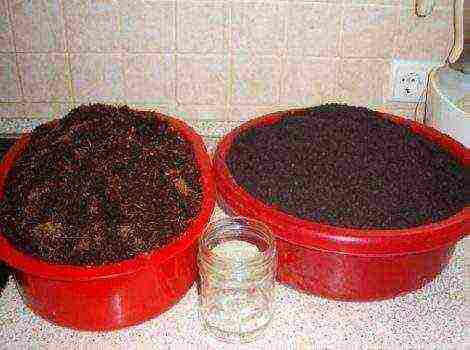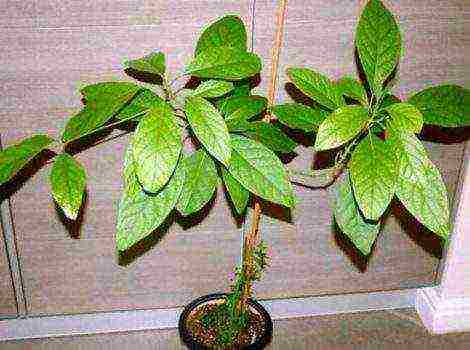Content
- 1 Time frames for cuttings roses
- 2 How to prepare cuttings correctly?
- 3 Use of growth stimulants
- 4 Rooting methods
- 5 Planting cuttings of roses from a bouquet to a permanent place
- 6 Seedling care rules
- 7 How to grow a rose from a cuttings at home?
- 8 Preparing cuttings
- 9 Rooting methods for cuttings
- 10 In water
- 11 In the soil
- 12 In potato tubers
- 13 In the package
- 14 The first way
- 15 Second way
- 16 Trannois cuttings method
- 17 Planting rose cuttings in the ground
- 18 Conclusion
- 19 Rules for preparing cuttings
- 20 Rooting methods for cuttings
- 21 Planting cuttings to a permanent place
Sometimes you don't want to part with the flowers you donated. In this case, you can make a little effort and grow seedlings for further planting in permanent soil.
Many people are interested in how to grow a rose from a cut from a bouquet. Especially if the variety is unusual or extremely dear to the heart. If you wish, you can root the flower you like, and you should not delay with this.
Time frames for cuttings roses
The most successful will be the propagation of roses by cuttings that were cut in the first summer months. It is advisable that the flowers are previously grown in the local climate and not treated with chemicals to prolong the life of the buds.
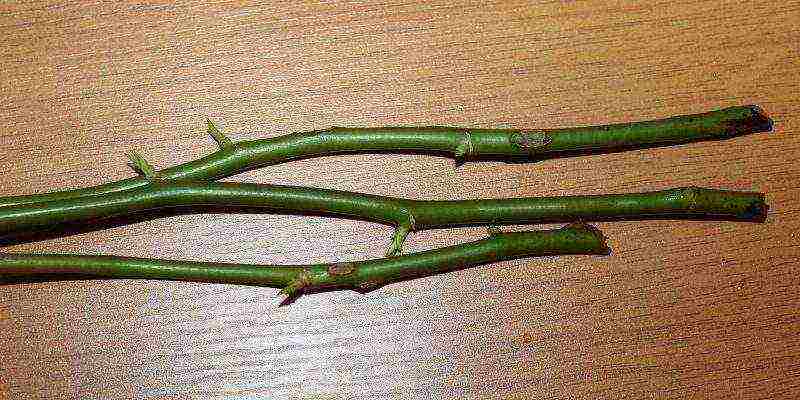
The best times for germination of cuttings are June days, in August it will be more difficult to achieve the formation of roots on the stems. The hardest part is to grow the plant during the winter months, and keep the cuttings of the roses until spring.
Do not delay receiving cuttings for several days after receiving the bouquet. Fresh flowers brought home on the same day are more likely to germinate.
How to prepare cuttings correctly?
For grafting, it is necessary to select the strongest flowers with beautiful buds from the bouquet. Their stems should be at the initial stage of lignification, that is, be brown. Too immature ones do not yet have the strength to germinate, and dark brown ones are already beginning to rot.
If the flowers are fresh, cuttings can be prepared immediately. When the roses have stood in the vase for a couple of days, it is necessary to cut off the cuts by a couple of centimeters and place them in cold water for 4-6 hours.
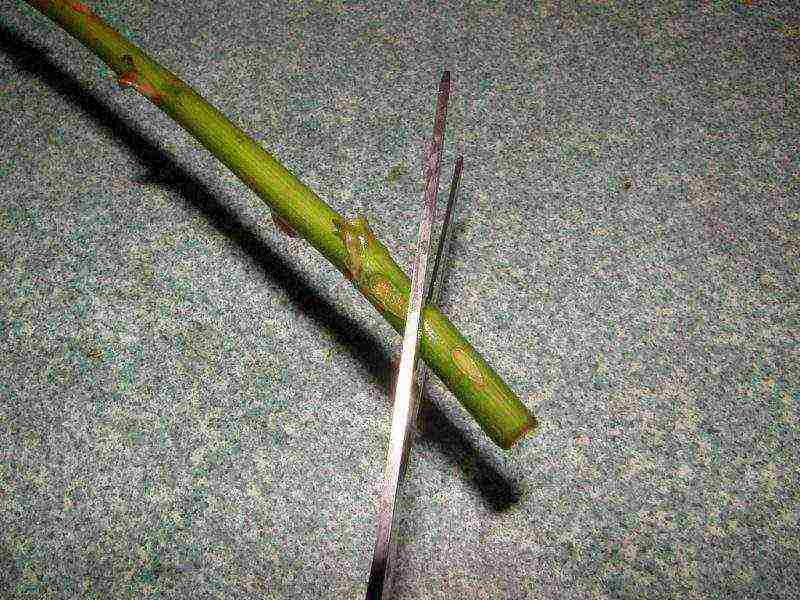
Preparing cuttings:
- Cut the buds from the selected flowers. You will no longer need them to plant flowers.
- Cut the stems into cuttings from 15 to 30 cm. It is recommended to leave at least 3 buds on each cuttings. The top should be 1 cm below the end of the apex, and the bottom should be 2 cm above the base.
- The top cut should be straight, the bottom cut at an acute angle.
- Remove all the lower leaves from the cutting, and cut the upper ones by a third.
- Place the cut stems in water to which the root growth stimulant has been added for 6 hours.
- Then you can start rooting the rose in any way possible.
Cuttings that have been formed from the middle of the stem take root most well. However, it is recommended to keep all of them, as the chances of germination of most of the flowers increase.
The pruner or flower knife should be very sharp so that the stem does not break during pruning. In addition, the instruments must be disinfected before work.
Use of growth stimulants
To increase the chances of root germination and speed up this process, a ready-made preparation or one prepared by yourself should be added to the soaking water. It is necessary to soak the cuttings in solutions from purchased additives for several hours, while a self-prepared growth stimulator acts throughout the day.
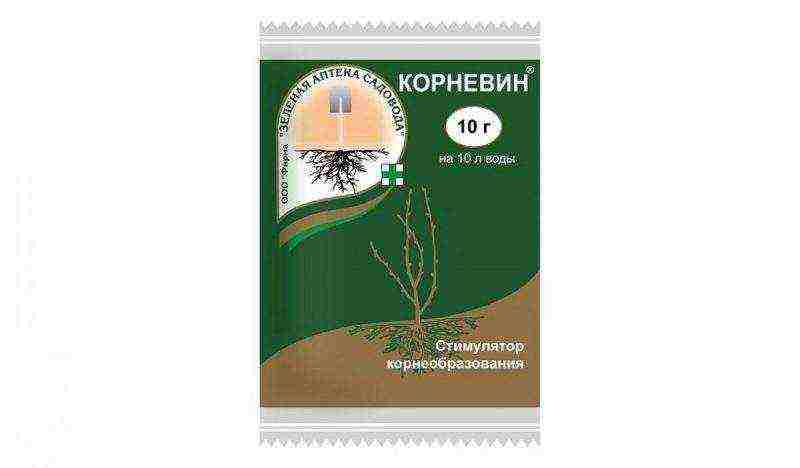
What can you soak cuttings in:
- Kornevin (1 gr.per 1 liter of water);
- Heteroauxin (1 tablet for 2.5 liters of liquid);
- Radifarm (2 drops per 1 liter of water);
- Zircon (1 ml per 10 liters of liquid);
- Epin extra (1 ampoule for 2 liters of water);
- aloe juice (the composition forms 9 parts of water and 1 part of juice);
- water with honey (1 teaspoon of beekeeping product is added to half a liter of liquid).
Of all the listed biostimulants, Radifarm is the most active. Therefore, the time for soaking cuttings in it is reduced to 30 minutes.
Rooting methods
There are several ways to grow a rose from a cutting. Most often, flowers are germinated in water or soil. However, there are more interesting options. For example, gardeners grow roses in bags, potato tubers or newspaper.
Germination in water
This option is the simplest, fastest and most affordable. An important step in germination in this way is the selection of high-quality water. Rain or spring liquid is most suitable, and tap water is also suitable.
However, the liquid from the pipeline must be prepared in advance. It must be filtered, and then allowed to stand for a day.
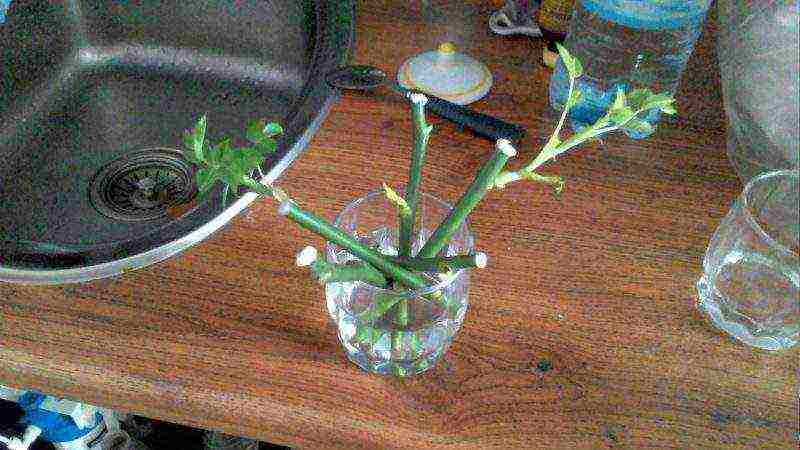
How to germinate roots:
- Pour a small amount of water into the jar.
- Dip the prepared cuttings into the liquid by about 1-3 cm.
- Remove the container to any place where direct sunlight does not fall.
The water should be changed every 2 days. Growing with this method takes about 3 weeks. Initially, white formations will appear on the stems, from which the consequences will grow new roots. This method has a significant disadvantage - often part of the cuttings irrevocably rots.
In pots
The method of growing roses in pots is a little more complicated, and at the same time it is one of the most effective.
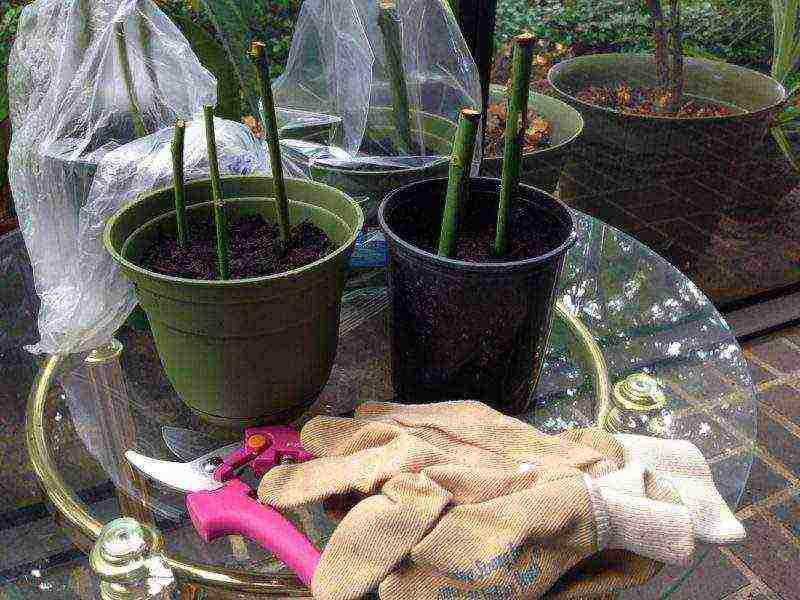
For rooting you will need:
- bottom container for soil;
- upper transparent - for the formation of a mini-greenhouse;
- potassium permanganate solution;
- priming;
- some small stones and sand for drainage.
Initially, you need to choose a suitable container for disembarkation. If one cutting is grown, a 0.5 liter pot will suffice for it. Accordingly, with an increase in the number of future flowers, the capacity and its capacity increases.
Steps for rooting in a pot:
- Process the container for planting with potassium permanganate. This will disinfect it from harmful bacteria.
- Put small stones for drainage on the bottom, then pour in a suitable purchased soil mixture, tamp it slightly. You can prepare the soil yourself. To do this, you need to take garden soil and sand in a 2: 1 ratio. Be sure to disinfect the resulting soil.
- Make a small depression in the ground, place the stalk in it. If several of them are planted, the distance between them should be about 6 cm. Compact the loosened soil, pour with settled water.
- Form greenhouse conditions. To do this, cover the planted cuttings with a jar or plastic bottle if they are in a pot. The seedlings in the box are covered with foil.
- As the topsoil dries out, spray it with a spray bottle.
The room temperature should be at least 25 degrees during the day, and at night the mark on the thermometer should drop to 18. The germination of cuttings should be judged by the appearance of new light green shoots after about a month.
At this stage, it is necessary to periodically begin to remove the shelter from the roses. First, airing is performed for 3-5 minutes, then gradually the time can be increased.When full leaves appear, the greenhouse is removed completely.
Growing roses in a bag
Rooting the stems in a bag is also a way to help provide future seedlings with maximum moisture and greenhouse conditions. The method is good because it does not require additional packaging for planting.
Stages of growing a rose:
- Fill the bag 1/3 full with soil suitable for these flowers.
- Treat the cut of the cutting with a solution to enhance root formation, place it in the ground.
- Fill the remaining space in the bag with air, tie and hang close to the window.
The first shoots begin to appear after 2 weeks. It will be possible to transplant the resulting seedlings into the ground in a month.
Using potatoes
The main advantage of growing a strong root system of a rose in a potato is a suitable tuber moisture and nutrition of the cuttings with an optimal amount of carbohydrates. This method allows you to get strong seedlings without spending much effort on it.
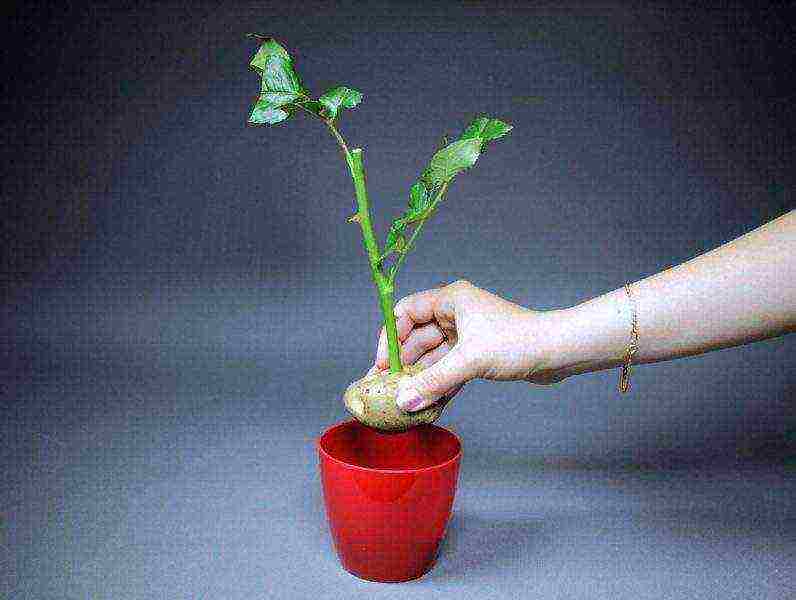
Initially, you need to prepare the potatoes. The tuber should be of medium size. It should not be rotten, have damaged areas or loose skin. Rinse the potatoes thoroughly, disinfect in a solution of potassium permanganate and dry.
How to germinate a rose stalk in a potato:
- Cut a groove in the tuber, a little short of the opposite side. In width, it should repeat the diameter of the stem.
- Treat the cut of the future flower with a growth stimulant, place the stem in the potato.
- Pour earth into a pot, put a tuber on it, sprinkle with soil on top.
- Drizzle with water.
- Set up your greenhouse as a bottle or jar.
When sprouts appear, it is recommended to start gradually ventilating the seedlings. After a couple of weeks, the top container must be removed completely.
Germination in the newspaper
This method is also called the "burrito method", as the cuttings rolled into the newspaper really resemble this food product in shape. From the materials you will need a bag, newspaper and chopped stems.
Stages of germination using a newspaper:
- Place several cuttings on paper at once. First bend it at both ends of the stems, and then roll it over. It will turn out from a newspaper a roll, inside which there are future seedlings.
- Dampen paper abundantly with water. Make sure that it does not break.
- Put the burrito in a plastic bag, tie it up.
The package should be removed to a place where the temperature will be kept at around 20 degrees. Once a week, you need to unfold the paper, moisten it, inspect the condition of the cuttings. If some copies have rotted, they must be removed and the newspaper replaced with a new one. Roots are formed after about 2 weeks.
Planting cuttings of roses from a bouquet to a permanent place
The most suitable time of the year for planting these flowers is late spring or early summer. Planting roses with cuttings in the fall does not make sense, since the plant will freeze in the ground.
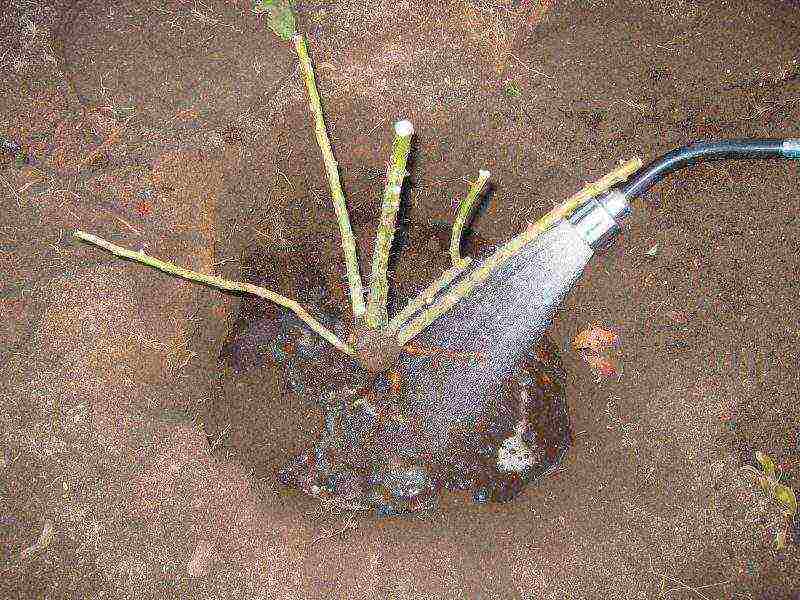
The landing site must be sunny, where there are no strong winds. The soil should not go deeply, as excessive water will drain into it during rain.
In the selected area, it is required to form pits of a suitable size, the diameter of which is equal to the root system. It is recommended to fertilize the soil, after planting the soil must be watered. Sprinkle the ground with sawdust or peat on top. Cover the seedlings from direct sunlight.
Seedling care rules
Fertilizer will be required for seedlings that have grown more than 12 cm. For this, complex solutions or infusion of herbs, mullein are used. For the plant to be strong, in the first year, you must immediately cut the flower buds after they appear. This will allow the rosebush to put all its energy into forming healthy stems.
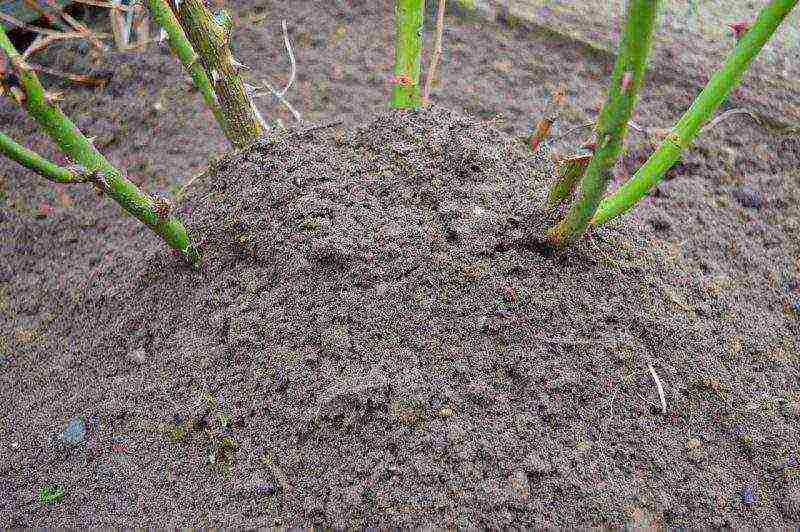
In advance, you need to take care of the shelter of the plant for the autumn-winter period. This will save the bushes from frost. Some specimens should be excavated and stored in a cool, damp place.So roses from a bouquet will appear in the garden again and again, delighting not only the gardener, but also everyone around.
There are different ways of propagating roses, but we will focus on the most popular one = from the cuttings. Very often we manage to get a stalk of the plant we like, and it is unknown what to do with it so that it does not die. We will help you grow beautiful flowers from rose cuttings.
You can even grow a rose from a bouquet at home by properly rooting the stalk.
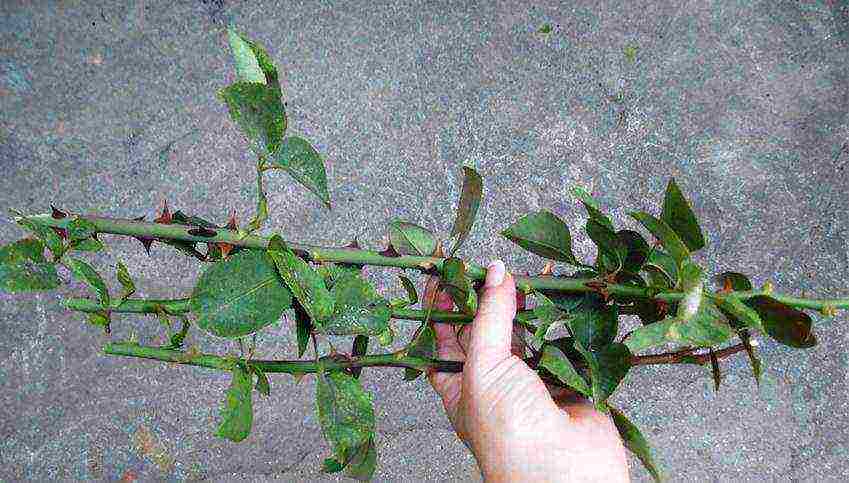
How to propagate roses by cuttings
This is a simple method of cutting three-bud cuttings and then rooting them. But questions arise as to how to make cuttings correctly, is it possible to root cuttings in water?
The middle or upper part of a healthy tree shoot, which is already finishing flowering, is best suited for cuttings. Using a special garden knife or secateurs, it is necessary to cut the shoots 10-15 centimeters long, each of which must have at least 3 buds. Cut them so that the lower cut, made at an angle of 45º, is directly under the lower kidney, and the upper (straight) one is above the upper third kidney. The technology of growing roses involves partial removal of leaves (this is necessary to reduce volatility). In this case, the lower leaf is completely removed, and the upper ones are shortened by 1/3.
How to plant a rose stalk
Ideally, what is needed: a sufficient amount of light, an air temperature of + 23-25 ° C, moderate watering and spraying.
Consider two ways of rooting rose cuttings:
- in the soil - for this they are planted obliquely on a prepared bed (if cuttings occur in late spring or summer), or at home in pots with a substrate of peat, sand (most) and fertile soil. Cover the planting with a glass jar, creating a small greenhouse. Water the plantings as needed, and before planting the cuttings in the pot, add well-washed coarse-grained river sand, into which you need to stick the cutting (the sand will prevent the plant from rotting due to excess moisture). When he begins to give young shoots, you can sometimes open the jar to remove condensation.
- in water - for this, the cuttings are placed in a container with water and left in a warm, well-lit place. From time to time, the water needs to be changed and topped up, and after 20-25 days the cuttings will have roots and they can be transplanted into pots with soil. You can add a root formation stimulator to the water for rooting the cuttings - then the roots will appear faster.
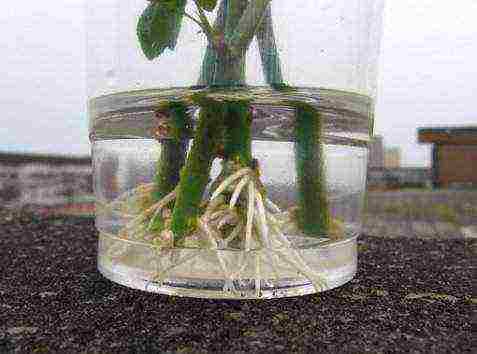
How to grow a rose from a bouquet
Very often there is a desire to grow the same flowers from a beautiful bouquet of roses. This can be done, you just need to cut the cuttings in time and germinate them correctly. Cuttings are carried out when the flowers begin to shed their petals.
Cuttings are cut as usual - from the bottom at an angle of 45º, and straight from the top. There should be 1-2 buds on the handle. It is better to root shoots from a bouquet in the soil according to general rules, but they must be stuck into the substrate strictly vertically, deepening to the first bud. With proper care, they will take root in about a month and start producing young shoots. It should be noted that cuttings of local varieties of roses take root better.
If the plants have taken root in the garden in the garden, then by winter it is better to dig out the first-year cuttings and transplant them into pots for wintering, which must be removed to the house or to a dry cellar. And in the second year, they can already winter in the garden right in the soil, provided that the flowers are securely sheltered for the winter.
To make roses resistant to diseases and pests, you need to take good care of them - water and feed them in a timely manner. The first feeding is needed when young seedlings reach a height of 15 centimeters. For feeding, it is advisable to take a complex fertilizer, at a dosage of 15 grams per 10 liters of water. Please note that nitrogen fertilization of roses should be stopped in the middle of summer, but fertilizers with phosphorus and potassium can be applied until autumn.
Growing a rose from a cutting, video
A stalk of a rose in a potato, why?
In this way, the potato tuber provides nourishment and moisture to the roots and the cuttings grow faster.
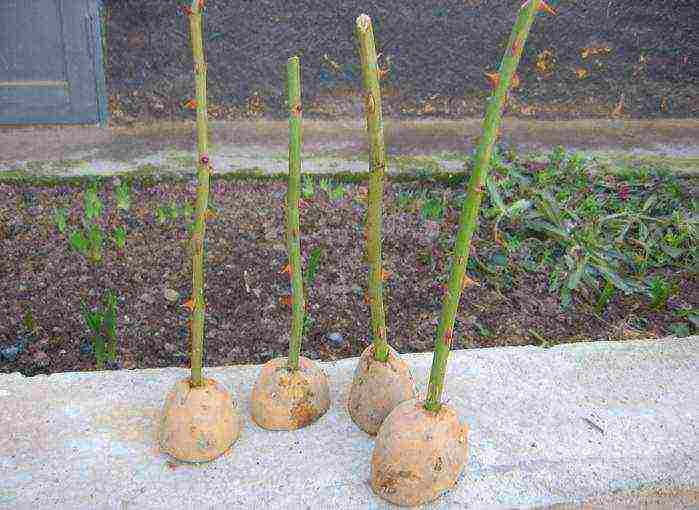
Fresh potatoes contain an optimal range of nutrients. It is a long-term source of constant moisture and reliable protection against hypothermia, decay, and the development of bacterial diseases that sometimes affect roses at the initial stage of growth. In addition, it is technically easy to grow a rose stalk in fresh potatoes.
To germinate rose cuttings, take tubers recently dug, not sluggish and not spoiled. Remove all eyes to prevent germination.
If the cutting is grown in a pot during the winter, then simply select the dense, large potatoes.
For cutting cuttings, it is not recommended to use shoots with unripe buds, as well as with already faded roses, since it is very difficult to root such cuttings - they simply do not take root. Reproduction by cuttings is also possible with a purchased rose from a bouquet - there is no fundamental difference. But keep in mind that Dutch roses are treated with a preservative composition that ensures long shelf life, they are almost impossible to root.
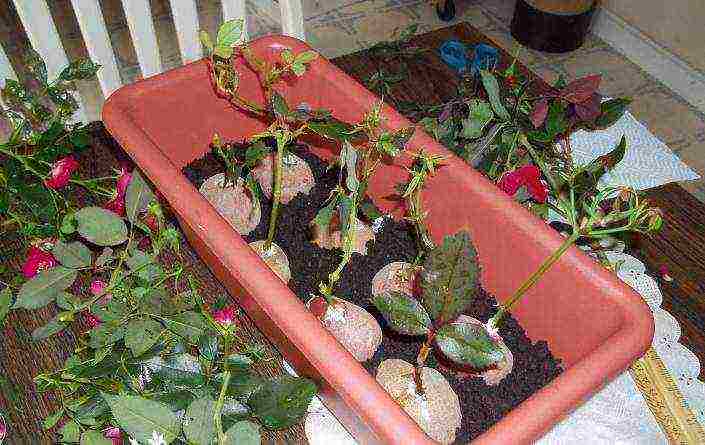
The length of the cutting should be 15-20 cm. Thus, from one rose or one shoot of medium length, you can get 3-4 blanks for propagation. Cut the cuttings with a sharp tool, preferably with a garden pruner, so that the stem does not squeeze when cut. The lower cut is made 2 cm below the kidney at an angle of 45 °, the upper one is 1 cm above the kidney, and the cut itself can be either at an angle or straight. All lower leaves of the cutting must be removed.
Next, the cuttings are treated with a weak solution of potassium permanganate, and then put in a stimulating solution of any root formation stimulator prepared according to the instructions for a day. You can replace these products with fresh aloe juice.
After all the preparations, the cuttings of the roses are stuck in the bottom part into the prepared hole in the potato. I will clarify that the propagation of a rose in a potato is only suitable for upright varieties. To grow a climbing rose, not a cutting is used, but a layering - a buried shoot rooted in the soil, because growing a layering in a potato tuber is very difficult.

You can root a rose in a potato tuber at home in a pot, or by immediately placing it in open ground. Planting cuttings directly into the ground gives an advantage - the roses will not need to be transplanted, and this will allow them to bloom in the same year or next spring. The area for planting cuttings should be light, without stagnant water and protected from the wind. Further landing technology is as follows:
- dig a trench 20-30 cm deep (for planting in rows, or for further transplanting to another place) - for planting single bushes without transplanting, separate holes are dug for each plant;
- pour a layer of river sand at the bottom of the pit - this is necessary to exclude contact of the tubers with the ground, and to prevent rotting of the potatoes themselves, and with it the cuttings;
- stick the prepared cuttings of roses into the holes made in the potato tubers;
- place the planting material in a trench at a distance of 15 cm from each other;
- fill a trench 2/3 with earth mixed with sand, lightly tamp.
Planting must be provided with a good level of humidity. Watering should be regular, but not too intense. For the first time, it is recommended to cover the cuttings with a plastic bottle with an unscrewed cap (to ensure air access). On sunny days, the plants need to be shaded; on cloudy days, remove the bottle completely. After about a month, when the cuttings take root, the shelter is completely removed.
Planting a rose stalk at home
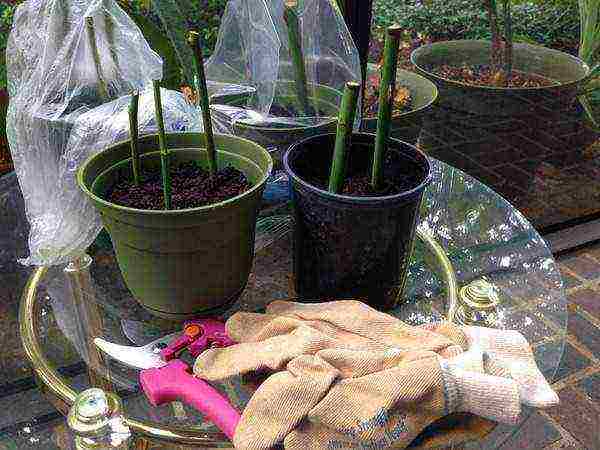
Prepare planting containers for germinating roses in potatoes at home. At the bottom of the pots, you need to lay drainage, then fill the containers with potting soil (any store soil for flowers will do), together with sand. Place the sprout potato in the pot.Sprinkle with soil.
In order for the cuttings to take root sooner, the soil must remain moist, so at home, in addition to watering, it is recommended to additionally spray future roses with water. A shelter made of a glass jar, plastic bottle, or plastic bag will help maintain warmth and humidity. After the buds begin to develop on the cuttings, the shelter is removed, and the seedlings are gradually adapted to environmental conditions. Particular attention should be paid to the quality of the lighting, but care must be taken to ensure that the sprouts do not overheat under the lamps.
Currently, many flower growers strive to grow beautiful and beloved flowers, not only in garden and summer cottages, but also at home. Rose lovers are no exception.
The image of a rose has many meanings: it is a symbol of perfection, pride, wisdom, love, silence and mystery. Images of paradise, heart, beloved, Venus, Mother of God are associated with her. There are few people in the world who will remain indifferent to such perfection, because she will be able to decorate any celebration, holiday, garden, apartment, and will also bring a lot of admiration to close and dear people. Is it possible to grow a rose from a cuttings at home? It turns out you can. We will consider how to do this later in the article.
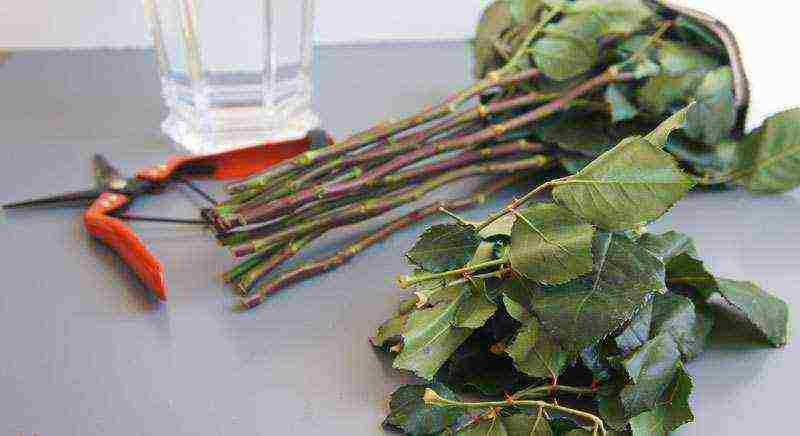
How to grow a rose from a cuttings at home?
There is nothing difficult in propagating a rose by cuttings, and even a novice gardener can cope with this without much difficulty. It all depends on the well-chosen material for planting and the precise execution of simple rules.
But it must be borne in mind that not all varieties of roses will be able to submit to the propagation method by cuttings. For example, it is doubtful that wrinkled and yellow park roses will be able to please you with established cuttings, but there will be no problems with miniature and climbing species of these beautiful flowers.
The advantage of the method of propagation of roses by cuttings is that the plants obtained with its help do not form root shoots, and this greatly simplifies care.
It is more successful to carry out such events from the end of June to the end of July, when the rose fades and its leaves and petals begin to fall off. Such a basis has the most chances to revive the finest specimens. But just as often, cuttings are carried out in late autumn, and they even try to grow cuttings of a rose in winter.
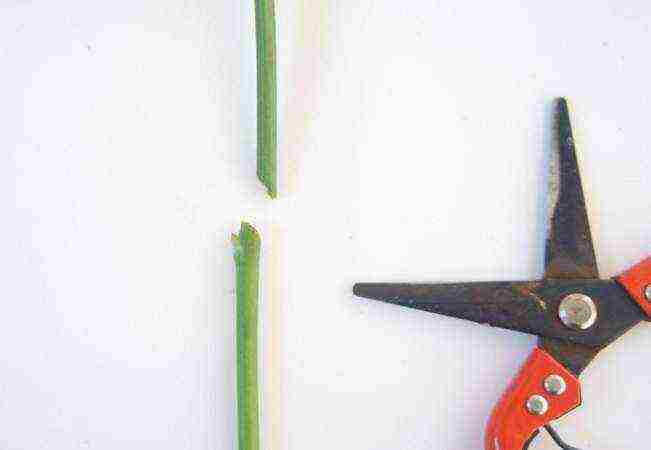
Preparing cuttings
Young and herbaceous flower shoots are completely unsuitable for cuttings at home. But the stems of one year of life, with a girth of approximately four to six millimeters, which either have not yet begun to bloom, or are already fading, are perfect for these purposes. It's all about the significant content of the amount of carbohydrates in such cuttings, which contribute to faster and more efficient rooting.
How to grow roses from cuttings of donated roses or grown on your own flower garden? Let's talk about this further.
Cuttings of roses should be cut to a length not exceeding 25 cm. When cutting the stems into cuttings, it is very important to make sure that there are at least three buds on them. Cutting cuttings should be done with a sharpened tool (for example, a special pruner), treated with alcohol and boiling water. The lower cut is made obliquely - at an angle of about 45 degrees under the kidney. The upper cut is made straight, slightly higher than the kidney. In addition, at the bottom cut, it is better to make another light cut along the stem, about two centimeters long. This will speed up root formation.

We must not forget that until the roots have formed in the cutting, its moisture reserve will not be replenished. Therefore, it is very important to reduce the volatility of the existing one. For this purpose, the leaves are partially removed: the upper ones are cut off by about a third, and the lower ones are removed completely.
To increase the percentage of successfully rooted cuttings, experienced gardeners resort to keeping the bottom cut in various liquid biostimulants for plants for half a day (for example, in "Heteroauxin" or "Epin"). Or they simply dip the cut into a dry powdery biostimulant (for example, in "Kornevin"). You can do without them, but this increases the risk of not having a good result, since the use of stimulants in certain quantities has a beneficial effect on the survival rate of cuttings. At the same time, it is very important not to allow the concentration of these substances to be exceeded, otherwise it can negatively affect the flowers. Therefore, it is necessary to strictly follow the instructions indicated on the packaging of such drugs. Consider ways to grow a rose from a cut of a purchased rose or one grown on your site.
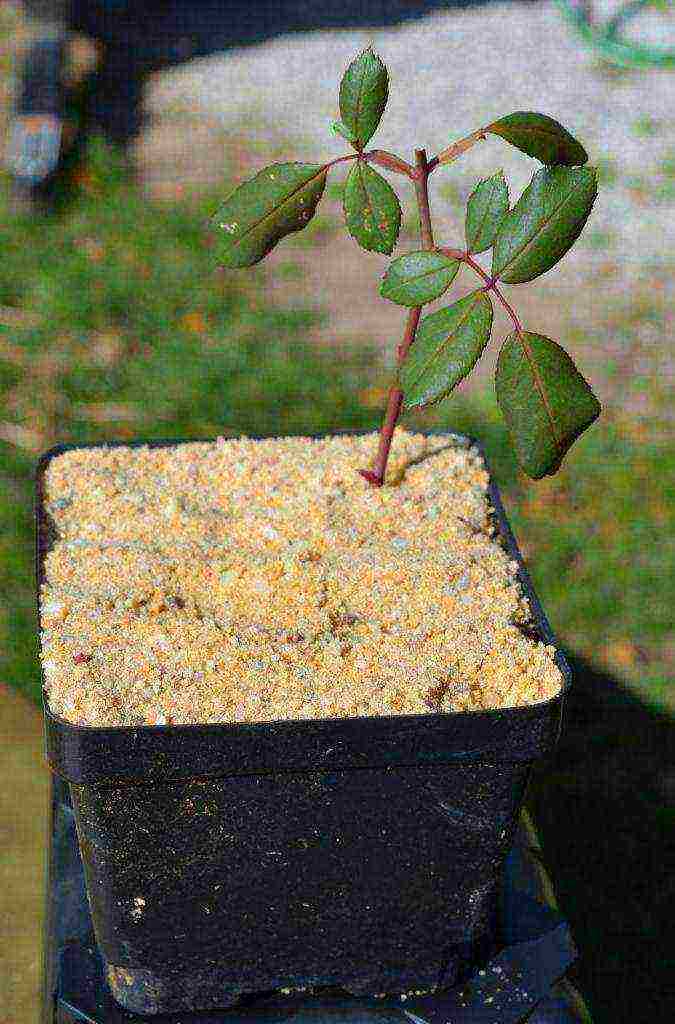
Rooting methods for cuttings
Prepared cuttings can be rooted using various methods, of which there are a lot. However, the most effective are:
- in potatoes;
- soil;
- water;
- packages.
In water
Consider how to properly grow a rose from a cutting in this way. This is one of the simplest and most popular rooting methods. Shoots prepared using the above method should be placed in cool boiled water. The water must be changed every two to three days. Thus, after a month, roots will begin to form in the cuttings, which can then be planted in the ground. Following this, the cuttings will need to be covered with plastic bottles and not removed until leaves form.
For this method of cuttings, it is better to take young shoots from the side branches of the flower.
However, when using this method of rooting cuttings, some nuances must be taken into account. Firstly, it is better not to put a large number of cuttings in one container - they will be cramped. Secondly, you cannot pour a lot of water into the container, as this is fraught with a lack of oxygen at the bottom of the container and the subsequent death of specimens from decay. Therefore, just in case, you need to prepare for the fact that not all cuttings can survive and take root. In addition, this method is not suitable for all types of roses. The most successful result will be with ground cover and dwarf species.
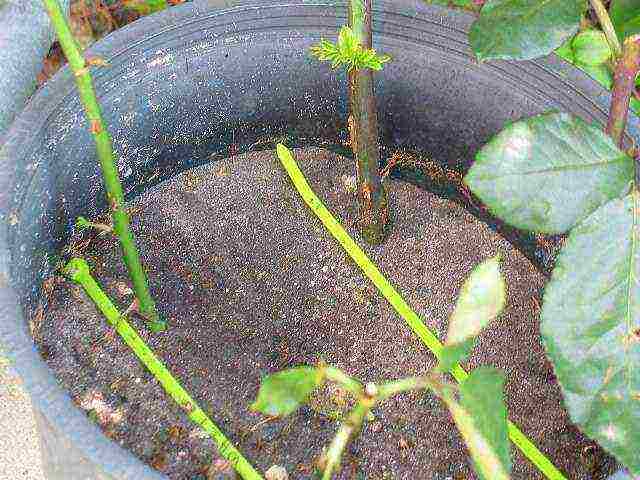
In the soil
And how to grow a rose in soil from a cuttings at home? This type of rooting is the most difficult in comparison with the others, but it gives a good result by increasing the percentage of plant survival.
How to grow a rose from a cutting? To begin with, pour a layer of drainage at the bottom of the pot. It is better to use medium-sized fragments of bricks or rubble as it. After that, the drainage is covered with a special soil for roses. It can be purchased ready-made from flower or garden shops. But the best option is to prepare the soil with your own hands. To do this, mix in a small pot in equal amounts sod and leafy soil with sand (1/3 sod land, 1/3 leafy soil and 1/3 river sand).
The prepared mixture is additionally covered with sand on top of 5-7 cm. When planting cuttings, it is worth checking that they are deeper than the layer of sand, that is, directly in the ground.
It is better to place the cuttings obliquely, with an oblique cut down, at a distance of about three to five centimeters from one to the other. The distance directly between the rows themselves should not be less than ten centimeters. After that, the flowers must be watered with clean water and covered with glass jars or plastic bottles with a cut-off bottom.
Roots will begin to form after 25-30 days. Throughout this period of time, the soil must be kept moist. When the first young leaves appear, in order to harden the plant, you can occasionally remove the jars (bottles), which can then be completely abandoned.
Carrying out cuttings in late spring or summer, some gardeners try to immediately plant roses in the garden, others still resort to using pots so that temperature drops and bad weather conditions cannot harm the plants. Moreover, in late autumn, in any case, it will be necessary to dig up the cuttings that have grown in the garden, and then transplant them into pots and remove them into the house so that the young bush will survive the winter.
In potato tubers
Now we will learn how to grow a rose from a cutting in a potato. This is a fairly common, effective and reliable method. To do this, the length of the stem of the flower should not be less than 25 cm. Potato tubers are better to pick up medium-sized, and also to remove the "eyes" from them in order to exclude their germination. Then, small indentations of a suitable diameter must be made in the tubers. Cuttings will be inserted there.
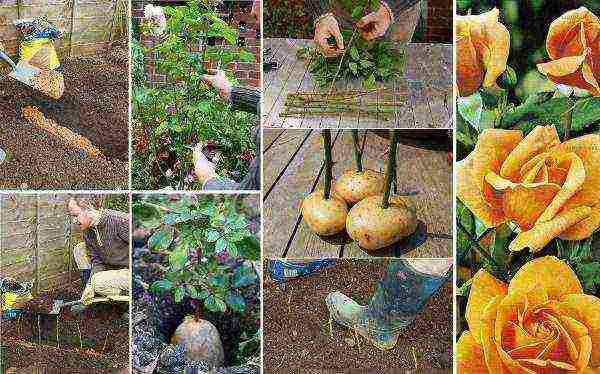
After that, take a suitable container, at the bottom of which a layer of sand about 3-4 cm deep is poured.Then, potato tubers with already introduced cuttings of flowers are placed in this container, keeping a distance of 10-15 cm from each other, which will need to be sprinkled with a small amount of earth ... Immediately after planting, tubers with cuttings must be irrigated with a thin solution of potassium permanganate (the solution should be weak, pale pink) and covered with jars. Likewise, the rose will get all the nutrition and nutrients directly from the potatoes. As for watering, then, despite all the moisture that the potato tubers create, it must be carried out regularly. And at least once a week, it is advisable to do this with the help of sweetened water. To do this, simply dilute 2 teaspoons of regular sugar in a glass of water.
Most gardeners choose this method, which ensures the highest survival rate of cuttings when growing flowers at home. Moreover, with further planting, their adaptation process occurs more painlessly and faster. Young shoots emerging from the buds will confirm the success of rooting.
In the package
Consider how to grow a rose from a cuttings in a bag. There are several ways, but the most popular are two of them.
The first way
Many will be interested in learning how to grow a rose from a cutting in this way. For this, in addition to the package itself, you will need moss. The moss is placed in a plastic bag, and then prepared cuttings are inserted into it. After that, the bag should be inflated tightly, tied securely and hung. With this method of growing cuttings, there is no need for watering, since the condensation that accumulates in the bag will moisten the moss and cuttings. And thus, the roots should be formed by the end of the fourth week.
Second way
To grow a rose from a cutting at home in this way, you need to soak about a dozen cuttings in water at room temperature for 24 hours, and then wrap it in a simple newspaper. The resulting bundle should be wrapped in a plastic bag or bag and left to be stored at home at a temperature slightly above 20 degrees.
Open the bag every week, inspect the cuttings and slightly dampen the paper. If for some reason the stalk begins to turn black or rot, then it must be thrown away so that rotting does not spread to other specimens. In this case, the paper should also be replaced to get rid of the mold.
After two weeks, the roots should appear.
This method is also called the Burrito Rooting Method. This method is considered ineffective. But despite this, he is popular with gardeners.
Trannois cuttings method
This is another way to grow a rose from a cuttings at home. However, it enjoys little public acceptance among gardeners and rarely gives the expected result. Growing flowers using this method should be carried out at the beginning or in the middle of summer.The essence of this method is to allow the stem of the rose to receive as much nutrition as possible from the leaves before cutting it. To do this, the cut stems are pinched and left until the buds swell in the lower part of the branches. When the buds swell, the wood begins to ripen, its readiness for growth and development will appear. In this process, it is very important to prevent the appearance of leaves from the buds, otherwise this reproduction will be completely ineffective.
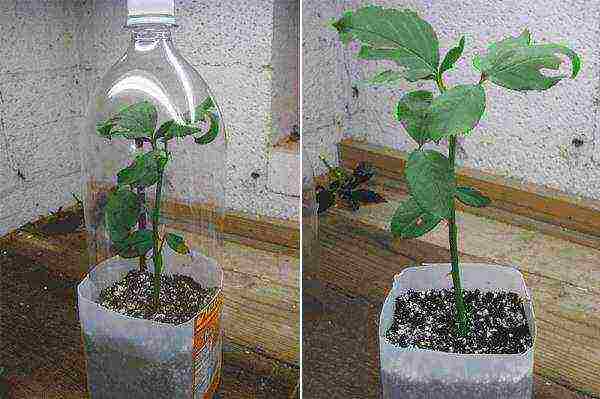
Planting rose cuttings in the ground
Once the roots appear on the cuttings, they can be planted in pots. But it is important to make sure that the upper bud of the cutting rises above the ground level.
A greenhouse effect should be created around the planted rose. To do this, the container with the seedling must be placed in a large polyethylene bag or covered with a plastic bottle with a cut out bottom. The container with seedlings should be in a room with an air temperature of about 25 degrees. In addition, rose sprouts require regular spraying with water from a spray bottle.
It is best to plant roses directly in open ground at the very end of spring, in the absence of a threat of frost return. Usually, a well-lit place without drafts and winds is chosen for this. The soil should be fertilized with organic substances, and if necessary, add mineral components.
Saplings need to cut off the stems, leaving three to four buds. And do not dig large holes, there will be enough depth for the size of the roots. After planting, the roses need to be watered and sprinkled with sawdust to retain moisture. At first, rose bushes should be protected from direct sunlight. The adaptation period of seedlings in a new place lasts about half a month, and then they begin to grow.
Whichever method is chosen, it is important to remember that the best result is easier to obtain at a favorable temperature, which should be about +25 ° C, as well as with good illumination and timely watering.
Conclusion
Summing up, we can say that there are currently not so few methods and ways of growing a rose from a cutting at home. Each of them has its own disadvantages and advantages, some of them are less effective, but more convenient, and vice versa. Therefore, when choosing a method to grow these magnificent flowers, it is important to remember that roses are capricious plants and require good and complete care.
There are several ways to grow roses on the site, and one of them is rooting cuttings from a bouquet. No matter how beautiful the flowers donated, they will soon wither in a vase, so why not recreate this beauty in your garden? The process of growing by cuttings cannot be called simple, and not everyone succeeds the first time, but it is still worth a try. To avoid mistakes, you need to learn in detail about which roses are suitable for this, how to properly cut cuttings and other important nuances.
How to grow a rose from a cutting
Rules for preparing cuttings
Roses grown in local conditions and cut at the beginning of summer are distinguished by the greatest survival rate.
If roses are grown in the nearest area, the chance of survival is increased.
Most of the varieties imported from abroad are treated with special chemicals that slow down the wilting of flowers, but reduce their ability to root. Although such roses also sprout from experienced gardeners.
Foreign roses can also germinate
As for the timing: in June, the shoots are actively growing even under unfavorable conditions, therefore they take root better, but in August-September the vitality of the plant decreases, which also affects root formation in cuttings. Roses from winter bouquets take root worst of all.
Cut roses take root best in spring and early summer.
Another important condition: the flowers must be fresh.If the water in the vase is not changed for several days, the cuts rot, harmful microorganisms enter the tissue of the stems and the rose becomes unsuitable for rooting. Therefore, it is advisable to cut flowers on the same day when the bouquet is presented. If, for some reason, it is not possible to do this immediately, be sure to put the selected specimens in clean cold water overnight, after cutting the tips by 1-1.5 cm.
Do not leave roses in a vase for a long time.
For cuttings, roses with strong healthy stems in the lignification stage are chosen. This can be determined by the color of the shoots and the hardening of the skin on them. In addition, thorns are easily broken off in mature stems. Fully lignified shoots with a thick core do not tolerate long-term moisture and rot. And immature and too thin cuttings do not have time to root well, as a result of which they freeze out in winter.
To harvest the cuttings, you will need a very sharp knife or pruner so that the stem tissue is not unnecessarily injured during the cutting process. The tool must be disinfected, so you minimize the risk of contamination of the planting material.
Step 1. The roses they like are taken out of the bouquet and the condition of their stems is checked. Unopened buds and already opened flowers are cut off (they can be put in wide glasses or a small vase with cold water so that such beauty does not go to waste).
Bud pruning
Step 2. Flower stems are cut into cuttings of 15-30 cm. They retreat from the lowest bud down 1 cm and make an oblique sharp cut. Above the second kidney from below, at a distance of 1-2 cm, a cut is made again, but this time straight. It turned out a stalk with two buds. The remainder of the shoot and all other stems are cut in the same way.
Rose cuttings processing
Advice! If there is little planting material, you can cut cuttings with one bud. In this case, they are made from 6 to 8 cm long, with the location of the kidney in the middle of the cutting.
Step 3. On each cutting, the lower leaves are completely removed, and the upper ones are shortened by about a third. This will help reduce moisture evaporation and prevent the shoots from drying out. It is not recommended to completely remove all leaves in order to maintain the circulation of juice with nutrients in the cuttings. Finally, all the thorns are removed.
Step 4. Take a container with clean, settled water, dilute any root formation stimulant in it and immerse the prepared cuttings in the solution a third of the length. Soaking time is about 6 hours.
Soaking prepared cuttings in a root former solution
Advice! Aloe solution can be used as a stimulant for root growth: fresh aloe juice is diluted with water in a ratio of 1: 9. Honey water also gives a good effect: add a teaspoon of natural honey to 0.5 liters of water. The duration of soaking cuttings in such solutions is at least a day.
You should not exceed the concentration of the stimulant, as well as overexpose the planting material in the solution. After a day, the cuttings are taken out and rooted in any convenient way.
The most effective root stimulants
|
Kornevin |
A biostimulant containing phosphorus, potassium and essential macronutrients required by plants. It is produced in the form of a cream-colored powder. When using the product, it is necessary to work with gloves and observe other safety measures. | 1 gram per liter of water |
|
Heteroauxin |
Organic stimulant with high biological activity, non-toxic. Available in powder, tablet and instant capsule form | 1 tablet for 2.5 liters of water |
|
Radifarm |
A biostimulant based on plant extracts, enriched with trace elements and vitamins. Contains steroids, glucosides and amino acids that affect lateral root development. Available in liquid form | 2 drops per liter of water (soak time 30 minutes) |
|
Zircon |
Organic immunomodulator based on Echinacea purpurea extract. Effectively stimulates root formation, can be used simultaneously with Heteroauxin | 1 ml for 10 liters of water |
|
Epin |
An effective plant-based growth stimulator and immunomodulator. Non-toxic, can be used in combination with other drugs. Release form - ampoules of 1 ml | 1 ampoule for 2 liters of water |
Rooting methods for cuttings
There are several popular ways to root rose cuttings:
- in water;
- in the ground under cover;
- in potato tubers;
- in the package.
Germination in water
The easiest option is to germinate in water. It is better to take spring or rain water, but if there is only tap water, be sure to filter it or at least let it settle. Roots will not develop in a chlorinated environment. The filled container is placed in any convenient place, protected from direct sunlight, and the cuttings are lowered into it. It is very convenient to use glass jars for these purposes - this way the planting material is always in sight. Only the lower tips of the cuttings should be in the water; they do not need to be immersed too much, since excessive moisture contributes to tissue decay.
Cuttings in water - photo
Every two days the water in the jar is changed to fresh, and so on for 2-3 weeks. After 15-20 days, whitish growths form on the sections, from which the roots develop. Already at this stage, the cutting can be transplanted into the ground, although experienced gardeners are advised to wait a few more days so that the roots develop more strongly. The main disadvantage of this method is the low concentration of oxygen in the water, due to which the roots either do not germinate at all, or develop very weakly and rot.
Rooting in pots
Most often, roses from a bouquet are rooted in pots and mini-greenhouses, where they are provided with the most optimal conditions. In this case, the roots develop more strongly, they are much stronger and more resistant to adverse factors. For one cutting, a small pot or a 0.5 liter plastic cup is enough. Many people use a cut plastic bottle for this purpose. If all cuttings are planned to be rooted in one box, it should be noted that there should be at least 6-8 cm between the seedlings.
Step 1. The container for germination is treated with a strong solution of potassium permanganate and dried. Prepare a soil substrate: mix 2 parts of garden soil and rotted compost and add 1 part of washed sand. If the soil is loose and fertile, it is not necessary to use compost. It is advisable to warm the finished soil mixture in the oven in order to destroy the seeds of weeds and pathogens in the soil. You can take a commercially available universal primer and save time.
Step 2... Small pebbles are poured on the bottom of the pots for drainage, then the prepared soil is poured to the very top, it is slightly compacted with your hands.
Powder the bases of the cuttings with a root stimulator
Step 3. With a spatula or a stick, they make a depression in the ground and carefully, so as not to injure the roots, lower the cutting. Two-bud cuttings are buried so that only the upper bud remains above the surface, single-bud cuttings are covered with earth only up to the bud. They compact the soil around the plantings, watered with water.
Planting cuttings
Step 4. Make a shelter to create a greenhouse effect.
Glass cover
Cuttings in separate pots are covered with half-liter glass jars, the boxes are wrapped in foil. After landing, it is necessary to ensure the temperature in the room is not less than + 25 degrees in the daytime, and + 18 at night. Containers should not be placed in an open, sunny place and in drafts.
Cuttings in a pot
Water as the soil dries up in small portions.
Spray the cuttings periodically with a spray bottle
Successful rooting is evidenced by small shoots appearing in the leaf axils. This usually happens a month later or a little earlier, depending on the variety of roses and growing conditions.
A favorable microclimate will be created inside the package, this will contribute to the rooting of the plant.
As soon as the first shoots appeared, the plant begins to air a little, removing the shelter for several minutes a day. Gradually, the airing time is increased, and when real leaves appear, they completely cease to cover. It is recommended to transplant rooted cuttings to a permanent place after strong young shoots are formed.
How to cut roses at home
Rooting with potatoes
Growing a rose right in a potato
Potato tubers provide the cuttings with an optimal moisture regime and nourish the developing roots with useful carbohydrates. Thanks to potatoes, you can get excellent seedlings with a developed and strong root system, and without much hassle. It is very important to choose the right tuber: it should not be sick, with damaged skin, lethargic. Such a potato in the soil will begin to rot and infect the cutting itself. Before planting, the potatoes must be washed, the eyes removed, disinfected in potassium permanganate and dried.
To begin with, prepare a plot in the garden: choose a bright and wind-protected place, dig a trench about 15 cm deep. A layer of sand 4-5 cm thick is poured onto the bottom and moistened well. They make deep, but not through holes in the tubers with a sharp knife, dip the lower cuts of the cuttings into Kornevin, insert them into the potatoes. Each cut requires a separate potato.
Use a screwdriver or nail to make a hole in the tuber
The tubers prepared in this way are lowered into a trench and buried in earth.
Tubers with cuttings are laid in a trench - photo
The upper kidney should be above the surface of the ground. Watered again with water, and then cover the plantings with cans, plastic bottles or film.
Burying a potato with a cutting
Further care consists only in regular moderate watering so that the earth does not dry out and is not too wet. With the appearance of sprouts in the internodes, the plantings begin to air, gradually increasing the time, and after 14-17 days, the shelter is completely removed.
Growing roses in a bag
This method is not among the most popular, but it is also used quite often. American growers call it the "burrito method." You will need a regular newspaper, a plastic bag, and cuttings prepared for rooting.
Step 1... Cuttings, processed and soaked for a day, are removed from the water and carefully placed on a newspaper.
Cutting roses using the burrito method
Step 2. The edges of the newspaper are folded over and a tight bundle is made, which is moistened abundantly with water. Excess water is allowed to drain to prevent the newspaper from falling apart.
Step 3. A bundle of cuttings is placed in a bag, tied and placed where the temperature is kept within 18-20 degrees.
A bundle of cuttings in a bag
Cuttings wrapped in newspaper sprouted
Once every seven days, the package must be opened, the cuttings must be carefully examined, and the paper must be moistened if necessary. If individual copies have turned black, began to rot, they are thrown away without regret, and the newspaper is changed. After a couple of weeks, roots should begin to form on the slices.
Root formation - photo
Planting sprouted cuttings
Planting cuttings to a permanent place
The optimal time for planting rooted cuttings is late spring, when frost is no longer threatened and stable heat sets in. The place for roses should be sunny, sheltered from the wind and level so that the roots of the bushes do not flood with water during rain. Planting pits are made according to the size of the roots, the soil is fertilized with organic matter. Before planting, the stems of the seedlings are cut, leaving 3-4 buds. After planting, the land is watered, be sure to mulch with peat or sawdust, the bushes are shaded from the sun with a covering material. The seedlings should start growing in about 10-15 days, after the adaptation of the root system in the soil.
Planting roses in spring in open ground
As soon as new shoots grow to a height of 12-15 cm, roses can be fed with complex fertilizers, herbal infusion or mullein infusion.
Watering and feeding roses
In the first year, the bushes should root well, so all buds should be cut off immediately after they appear, so that the plant does not waste energy on flowering. With the onset of autumn, it is worth providing young roses with a reliable shelter.
Planting roses in open ground after rooting
The most valuable varieties are recommended to be dug up and stored in a cool room until spring, maintaining the necessary humidity so that the roots do not dry out.
Video - Growing roses from cuttings from a bouquet
Video - Rooting cuttings in a package
